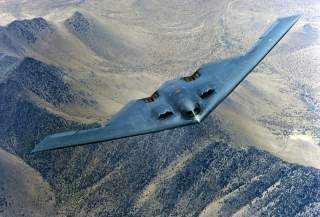The Air Force's New B-21 Stealth Bomber Will Be a High-Tech Doomsday Machine
Armed with nukes too.
Key point: The B-2 is already a powerful and sneaky bomber armed with nuclear weapons. But the B-21 promises to be even stealthier and with new technologies that will make it the ideal weapons system to carry out a strategic attack.
On October 27, 2015, nearly thirty-four years to the day after Northrop Grumman was awarded the contract to develop the first stealth bomber, the U.S. Air Force awarded Northrop a contract for a new bomber: the B-21 Raider. While many of the details of the Raider are shrouded in mystery, we do know a few things about it, and can infer others.
The B-21 Raider bomber takes its name from both the twenty-first century and the legendary 1942 raid by Gen. James “Jimmy” Doolittle’s force of B-25 Mitchell bombers against targets in and around Tokyo, Japan. In invoking the Doolittle Raid, the Air Force is drawing attention to attack’s audacious nature, the strategic and tactical surprise, and the epic distances General Doolittle and his “raiders” flew to accomplish their mission.
A tailless, batlike aircraft, the official rendering of the B-21 Raider released by the Air Force bears a superficial resemblance to the B-2 Spirit bomber. There are important distinctions, however. The B-21 moves its engines closer to the wing root, where they occupy the juncture between wing and fuselage, whereas the B-2’s twin pairs of General Electric F118-GE-100 engines are distinctly apart from the fuselage on the wing. The Raider’s engine air intakes are angled and not serrated like those on the B-2 Spirit. The Raider also has overwing exhausts to mask the infrared signature of the four engines, unlike the B-2. (Interestingly, this is exactly how the B-2’s exhausts were depicted in an April 1988 artist’s conception of that bomber.)
The aircraft appears similar in size to the B-2 Spirit, almost certainly making it a four-engine bomber. The announcement of Pratt and Whitney in 2016 as a B-21 subcontractor narrows down the new bomber’s engines to two designs: the F-100 and the F-135. The mature F-100, which powers the F-15 Eagle series of fighters, seems a sound choice, but the Air Force may want the F-135, which powers the F-35 Joint Strike Fighter, for its growth potential and ability to lower engine costs for the F-35 fleet.
Like its predecessor, the B-21 Raider will be a heavy strategic bomber designed to carry both nuclear and conventional weapons. If the B-2 is of similar size, it follows it will carry a similar amount of ordinance. This means two bomb bays. In order to keep costs down, the Air Force may elect to reuse the Advanced Applications Rotary Launcher from the B-2 bomber. The AARL is fitted one per bomb bay, each capable of carrying eight bombs or missiles.
In the nuclear mission, the Air Force will arm the B-21 with the Long-Range Stand-Off (LRSO) missile, the next-generation stealthy nuclear cruise missile. It will also carry B-61 free-fall nuclear gravity bombs, particularly the new B61-12 bomb with “dial-a-yield” capability. A combination of these two weapons will allow the B-21 to use its stealthy cruise missiles to clear a path through the enemy air-defense network before dropping B-61 bombs on primary and secondary targets.
For conventional missions, the B-21 will carry the JASSM-ER conventional cruise missile and two-thousand-pound GBU-31 Joint Directed Attack Munition satellite-guided bombs. The B-21 could use these weapons in a similar manner as its nuclear weapons, blasting its way through the enemy’s defenses before dropping JDAMs. Alternately, the B-21 could be used as a missile truck, launching up to sixteen JASSM-ERs at enemy targets from a distance, or penetrating less sophisticated enemy defenses to deliver JDAMs on target. The B-21 will also need to carry the thirty-thousand-pound Massive Ordnance Penetrator bomb, the largest conventional bomb in the U.S. arsenal, as the B-2 is currently the only bomber capable of lifting the enormous bomb.
Like many new weapons systems, the Air Force has instructed Northrop Grumman to build the bomber with a so-called “open architecture” hardware and software system. As a result, unlike previous bombers, the B-21 could become much more than just a heavy bomber. The open-architecture specification should ensure that future upgrades will be relatively easy to integrate into the B-21, and for the bomber to adapt to a slew of new, different missions. The bomber’s weapons bay could end up being more of a mission payload bay, with surveillance, communications, drone or electronic warfare packages loaded inside to facilitate a variety of missions, particularly in denied environments. The Raider is on the path to being America’s first multirole bomber.
The B-21 Raider is set to fly in the mid-2020s, and the Air Force plans to buy at least a hundred of the bombers to replace the B-52H Stratofortress and B-1B Lancer bombers. A larger fleet of up to two hundred bombers is possible, but entirely bound to fiscal realities. We don’t know what the Raider in its final form will look like, or when the Air Force will release more information on an aircraft it wants to carefully protect. The B-21 has disappeared into the “black” world of military technology, and will only reemerge when the bomber is ready.
Kyle Mizokami is a defense and national-security writer based in San Francisco who has appeared in the Diplomat, Foreign Policy, War is Boring and the Daily Beast. In 2009 he cofounded the defense and security blog Japan Security Watch. You can follow him on Twitter: @KyleMizokami. This first appeared in 2017.
Image: Reuters.

